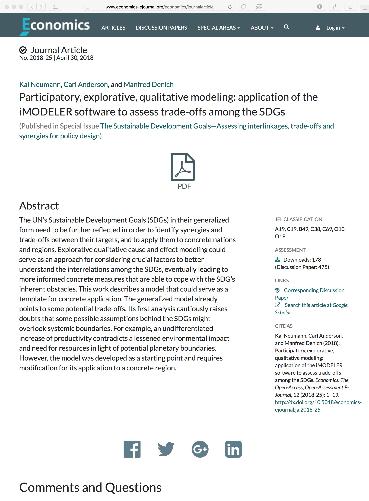Qualitative model on the UN's sustainable development goals (SDG) ExampleGhana
The content of this page is licensed under the Creative Commons Attribution 3.0 License.
Quick view of the model (open complete model with iMODELER):
 Kai Neumann (#1) has provided a description of the model with the iMODELER Presenter.
Kai Neumann (#1) has provided a description of the model with the iMODELER Presenter.
Description
https://www.know-why.net/model/CaLIsTKbVf7Yg5bm8yRXGyg discussed there and with an accompanying paper here: http://www.economics-ejournal.org/economics/discussionpapers/2017-82 (discussion paper) and peer reviewed here: Kai Neumann, Carl Anderson, and Manfred Denich (2018). Participatory, explorative, qualitative modeling: application of the iMODELER software to assess trade-offs among the SDGs. Economics: The Open-Access, Open-Assessment E-Journal, 12 (2018-25): 1–19. http://dx.doi.org/10.5018/economics-ejournal.ja.2018-25

Qualitative cause and effect model on the SDGs
This is a model that we (...) use for a paper yet to be published. Please copy (on know-why.net you find the link to insert it into your account) it into your free account of iMODELER in order to enhance it and weight the connections to fit a concrete region or nation. You may also consider two concrete countries, e.g. a developed country and a developing country.
Background:
The UN’s Sustainable Development Goals in theirgeneralized form need to be further reflected in order to identify synergies
and trade-offs between their (sub-)targets, and to apply them to concrete
nations and regions. Explorative, qualitative cause and effect modeling could
serve as a tool to add crucial factors and get a better understanding of the
interrelations between the goals to come up with concrete measures and to cope
with their obstacles. This model could serve
as a template for a concrete application. The generalized model already points
at some potential ambivalences as well as synergies that could be related to
some latest theories and concepts from economics, transition research etc.. Its
first analyses cautiously raise doubts that some possible assumptions behind
the original sustainable development goals might overlook some systemic
boundaries. For example an undifferentiated increase of productivity combined
with planetary boundaries and the only myth of decoupling of growth from
environmental impact and need for resources might be the wrong way.
Time horizon:
short term: within 3 years
medium term: within 3 to 10 years
long term: beyond 10 years
Source:
https://sustainabledevelopment.un.org/?menu=1300
as well as
https://unstats.un.org/sdgs/indicators/Official%20Revised%20List%20of%20global%20SDG%20indicators.pd...
Application:
After you have inserted the model to your free iMODELER account you should continue to use the 4 Know-Why Questions (what leads directly to more/less of a factor present/in the future?) in order to exploratively add hard and soft factors that help to explore what could serve as an effective lever to improve the situation in the world or for a concrete region.
You may also share your model collaboratively (only with a full version of iMODELER) to work with others on the same model.
5592 uses, 3462 views
